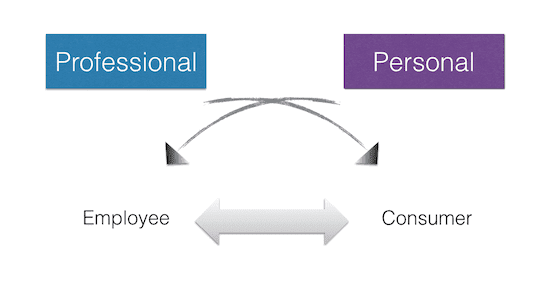As much as some cultures and companies try to refrain from mixing personal and professional, reality is that these two spheres are inevitably intertwined. For this reason alone, I keep emphasizing the mantra: branding gets personal. And I believe that the sooner corporate boardrooms come to grips with this — especially from an HR, IT and branding level — the better off the company will be.
The work / life balance or divide?
When an employee goes home, at the very least, she brings with her the challenges and consternations of the day. Very likely, she will also bring home some work that she might stealthily do after the kids are asleep or before they rise. What kind of working environment does she have at home to enable easy and complete access to her workstation? The more seamless that experience, the more efficient and effective she will be. Conversely, when a person goes to work, it is natural (and I would deem necessary) that, during the nine+ hours at the office, she be able to connect with her friends and family. Today, this means ineluctably having access to Facebook and Twitter, etc., not to mention making personal calls and text messages. If work-life balance is an elusive concept, the key is to be able to juggle both on each side of the equation. To this end, technology is truly becoming a strategic consideration. It’s not enough to declare free BYOD (bring your own devices) to work. What is being actively done to facilitate working from home? Is wifi easily accessible for personal devices at the office?
The employee as consumer
Another divide that is equally important from a business perspective is between employees and customers. Developing empathy and an ability to think as and for consumers is becoming evermore vital. So many employees (especially as senior managers) come to work and, while slipping on the corporate suit, seem to make abstraction of their lives as consumers. The excuse may be the pressure on results and shareholder return, yet, it is precisely the experience of and empathy with the customer that will make the difference longer term. Companies and cultures that privilege the “rational” and “financial” drivers of the business will undoubtedly struggle to adopt a customer centric attitude. {Tweet this!} As it is, CEOs and top management are already cut off from the “reality” of the customer experience by spending obscene amounts of time in meetings. When they do customer “meet and greets” or “store visits,” their experience is warped by well-t0-do managers who manucure the floor. Not that you always want to give the consumer what they want (otherwise, we would only be riding faster horses, to paraphrase Henry Ford); but, leaders need to embed honest listening into their board room. {Tweet this!} The Jeff Bezos “trick” of the empty chair is a fine substitute as long as the CEO allows others to invoke the customer in the face of the CEO’s suggestion.
The employee as evangelist
The “social employee” (as written about in the eponymous book by Cheryl and Mark Burgess) is a very special concept that cannot be injected into any culture without due warning and work. Ultimately, though, the best social employee feels as if the work about which he/she is chatting is merely an extension of his/her personal values, personality and, even, identity. {Tweet this!} When an employee is allowed to bring his/her full personality to work, the power and amplification of the social employee takes on another level. When an employee feels empowered to talk about the brand for which he/she is working, it is contributing to and reinforcing his/her personal brand. With a more evolved mindset, senior management (and HR teams) should consider helping their employees to develop their own personal brand. For, if the personal affairs are systematically left at home and the professional life is squirreled away at the office, the enterprise is bound to operate at a fraction of its effectiveness. {Tweet this!}
A brand, whose values resonate with its employees on a personal level, is bound to make for stronger convictions, a more engaged sponsor and, ultimately, a stronger customer relationship.” {Tweet this!}
Your thoughts and reactions are welcome!












Trackbacks/Pingbacks